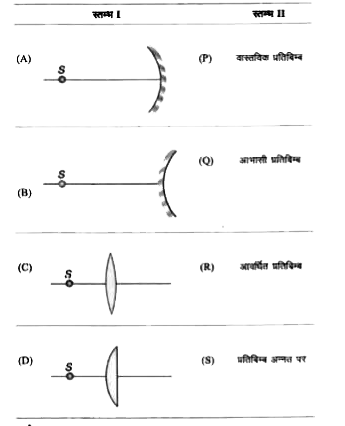Four rays of light above the optic axis (parallel to it) and their path after striking an optical system are shown in column-I . Match the corresponding optical instrument from column-II:
_E01_096_Q01.png) Solution in Gujrati
Solution in Gujrati
The correct Answer is:(A)-r (B)-q (C)-p (D) -s
Topper's Solved these Questions
- GEOMETRICAL OPTICSBOOK - ALLEN CHAPTER - GEOMETRICAL OPTICSEXERCISE - EXERCISE-04[A]
23 Videos
- GEOMETRICAL OPTICSBOOK - ALLEN CHAPTER - GEOMETRICAL OPTICSEXERCISE - EXERCISE-04[B]
18 Videos
- GEOMETRICAL OPTICSBOOK - ALLEN CHAPTER - GEOMETRICAL OPTICSEXERCISE - EXERCISE-2
44 Videos
- CURRENT ELECTRICITYBOOK - ALLEN CHAPTER - CURRENT ELECTRICITYEXERCISE - EX.II
66 Videos
- GRAVITATIONBOOK - ALLEN CHAPTER - GRAVITATIONEXERCISE - EXERCISE 4
9 Videos
Similar Questions
A plane mirror of circular shape with radius r=20cm is fixed to the ceiling .A bulb is to be placed on the axis of the mirror.A circular area of radius R=1m on the floor is to be illuminated after reflection of light from the mirror. The height of the room is 3m What is maximum distance from the center of the mirror and the bulb so that the required area is illuminated?
View SolutionTwo large plane mirrors OM and ON are arranged at 150° as shown in the figure. P is a point object and SS' is a long line perpendicular to the line OP. Find the length of the part of the line SS' on which two images of the point object P can be seen.

View SolutionTwo mirrors are inclined at angle θ as shown in figure. Light rays are incident parallel to one of mirrors. Light will start retracing its path after the reflection if
View SolutionIn the Bohr's model of hy drogen atom, the electron moves around the nucleus in a circular orbit of radius 5×10−11m. Its time period is 1.5×10−16s. The current associated with the electron motion is:-
View SolutionAssertion : The difference in the value of acceleration due to gravity at pole and equator is proportional to square of angular velocity of earth.
Reason : the value of acceleration due to gravity is minimum at the equator and maximum at the pole.
View SolutionColumn I shows the optical devices on which parallel rays fall. Column II shows the shape of emergent wavefront match them.
View SolutionFour indicident rays of light parallel to optic axis and their path after passing through an optical system are shown in table-1. match the corresponding optical instrument from table 2.
View SolutionIn Column-I are shown four diagrams of real object point O , image point I and prinicipal axis (optical axis). Select the proper optical system from Column II which can produce the required image (image may be real or virtual )
_E01_095_Q01.png)
View Solutionएक प्रकाशिक घटक, एक वस्तु तथा प्रकाशिक अक्ष स्तम्भ I में दिए गए हैं | प्रकाशिक घटक तथा वस्तु के बीच की दूरी परिवर्तनीय है | प्रतिबिम्ब के गण स्तम्भ II में दिए गए हैं | तदनुरूप स्तंभव II का सही मिलान कीजिए |

View Solutionएक प्रकाशिक घटक एक वस्तु S तथा प्रकाशिक अक्ष स्तम्भ I दिए गए है | प्रकाशिक घातक तथा वस्तु के बीच की दूरी परिवर्तनीय है | प्रतिबिम्ब के गुण स्तम्भ II में दिए गए है | तदनुरूप स्तम्भ I व II का सही मिलान कीजिये |

View SolutionFour rays of light parallel to optic axis, .and their path after passing through an optical system are shown in the following two columns. Match List - I with List - II and select the correct answer using the codes given below the lists:

View SolutionRay Optics And Optical Instrument | Optical Instruments – The Eye, Microscope
View SolutionRay Optics And Optical Instruments | Optical Instruments – Telescope.
View SolutionL_(1), L_(2) L_(3) If there is an optical system, match column-I to column-II.
View SolutionFour indicident rays of light parallel to optic axis and their path after passing through an optical system are shown in table-1. match the corresponding optical instrument from table 2.
View SolutionColumn I shows the optical devices on which parallel rays fall. Column II shows the shape of emergent wavefront match them.

View Solution

_E01_096_S01.png)